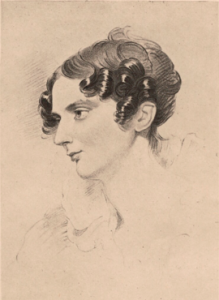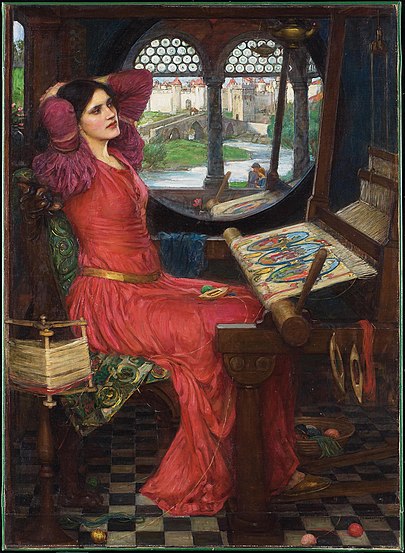“She walks in beauty, like the night.”
Thus begins Lord Byron’s famous poem. Reader’s Digest lists “She Walks in beauty” as #3 in their list of Famous English Poems. The website Discover Poetry puts it as #24. But regardless of where you place it, the work is clearly a masterpiece of poetry, in which the English language reaches near perfection. Set in iambic tetrameter, the poem flows with an ease that is both eloquent and unpretentious, drawing on images from the created world to describe the outward and inner loveliness of a beautiful woman.
She walks in beauty, like the night
Of cloudless climes and starry skies;
And all that’s best of dark and bright
Meet in her aspect and her eyes
Thus mellow’d to that tender light
Which heaven to gaudy day denies.
One shade the more, one ray the less,
Had half impair’d the nameless grace
Which waves in every raven tress,
Or softly lightens o’er her face;
Where thoughts serenely sweet express
How pure, how dear their dwelling-place.
And on that cheek, and o’er that brow,
So soft, so calm, yet eloquent,
The smiles that win, the tints that glow,
But tell of days in goodness spent,
A mind at peace with all below,
A heart whose love is innocent!

Byron wrote this poem in 1814 after a party in which he was particularly taken with one of the guests, Mrs. Anne Beatrix Wilmot, wife of Byron’s first cousin, Sir Robert Wilmot. His meditations on Anne’s beauty inspired the famous poem, composed the next morning.
For many in the modern world, this poem is not particularly special, perhaps just another instance of sentimental romanticism, or maybe a merely decorative way of describing a woman with a pretty face. Dr Oliver Tearle of Loughborough University calls it a “rather conventional poem,” that focuses on “everything we might expect a conventional love poet to praise,” while feminists have disliked it on the grounds that it allegedly objectifies women. Moreover, compared with the didactic drift of modern poetry, these verses may seem shallow and without substantive meaning. Earlier today I shared this poem with a family member and he replied, “Poetry is poetry to me…mostly the same, boring…pointless. I guess it’s fine. It rhymes. Poetry that means something is different.”
While I can understand these reactions, they all miss the point. One of the reasons this poem has resonated with so many people is that it encapsulates a truth we all know in our bones, that goodness is beautiful. What impressed Byron about Anne was not just her dark hair and soft visage; rather, he was struck by how her physical charms integrated with a rightly ordered soul, as reflected in serene thoughts, a peaceful mind, an innocent heart, and days in goodness spent. The gentle beauty of night becomes a metaphor for this woman’s loveliness, which comes not from the gaudiness of ostentation and display, but in the enchantment of her serene character.
Throughout the ages, Christian have taught that beauty is the splendor of truth and the radiance of the good. Together the triumvirate of goodness, truth and beauty make up what philosophers have called the transcendental attributes of being. Rightly understood, these transcendentals are inseparable from one another. Byron’s poem integrates the transcendental attributes of being in the image of a person who is not only beautiful and good, but who is beautiful as a result of her goodness. As such, she is an image of Christ’s character, in whom goodness, truth, and beauty are all perfectly harmonized.
Byron’s own life did not reflect this integration. He was a rascal and represented what is worst in the romantic movement. As Amanda Witt explained at Salvo, the romanticized cult of love led Byron to become a monster of cruelty and treachery. Yet because Byron lived at a time before the imagination had been wholly debased, when he wanted to describe pure beauty, he described someone who was good. I think it’s significant that “She Walks in Beauty” is Byron’s most memorable poem, not his more erotic verses like Don Juan.
I don’t need to tell you that our modern world tries to separate beauty from her sisters, truth and goodness. We live at a time when advertising and media corrupt the imagination by portraying the disordered as beautiful, and presenting what is false as seductive and attractive. However, the central task of good education, as C.S. Lewis pointed out so masterfully in The Abolition of Man, is to reorder our affections so our souls become attuned to the beautiful and the good. This is not achieved through intellectual instruction alone, but through the education of our affections. Lewis was particularly aware of how good stories and poetry, as well as rightly-ordered habits of thinking and acting, can incubate within the student a longing for the beautiful and a delight in what is good. This, of course, is our aim as teachers. Our goal is to equip students to have an aesthetic as well as an ethical objection to actions and dispositions that misfit their nature, so they instinctively recoil at what is disordered and base.
Learning to delight in what is beautiful ultimately trains our hearts for the joys of heaven, as we are formed into men and women who can find the presence of God a joy rather than a torment. For just as we can acquire dispositions that enable us to delight in what is good, true, and beautiful (ultimately in God Himself), it is also possible to corrupt ourselves so that heavenly joys would be torment, like Milton’s Satan whose hatred of earthly beauty portended his much greater revulsion against heavenly joy.
With what delight could I have walked thee [earth] round,
If I could joy in aught, sweet interchange
Of Hill, and Vallie, Rivers, Woods and Plaines,
Now Land, now Sea, and Shores with Forrest crownd,
Rocks, Dens, and Caves; but I in none of these
Find place or refuge; and the more I see
Pleasures about me, so much more I feel
Torment within me, as from the hateful siege
Of contraries; all good to me becomes
Bane, and in Heav’n much worse would be my state.
[Paradise Lost Book 9]
Even though Milton’s Satan hated the beautiful hills, valleys, and rivers of his earthly exile, he nevertheless preferred these to the torment he would undergo if faced with the beauties of heaven. Paradise Lost, like C.S. Lewis’s The Great Divorce, explores the paradox of a being who has become so corrupted that he prefers misery to the infinite pleasure of the beatific vision. The devil’s chief interest is to pass on this corruption to the human race, though this is rarely explored in resources on “spiritual warfare.”
It is naïve to discuss spiritual warfare without taking seriously how, in the contemporary world, the devil has an entire toolbox for corrupting our affections. The tools range from digital liturgies to music and advertisements that clothe a rival vision of the good life with a counterfeit beauty.
For one telling example, note how the songs of Taylor Swift present an organic link between beauty and badness. Consider her 2015 hit, “Wildest Dreams,” which integrate a man’s physical attractiveness with his bad character:
“He’s so tall and handsome as hell
He’s so bad, but he does it so well”
Even Swift’s own brand of female attractiveness is due, in a large part, to her image as a woman in which physical beauty blends with a certain weakness of character, as reflected in her 2022 hit, “Anti-Hero.” In this song, Swift confesses to “covert narcissism I disguise as altruism,” while returning to a refrain:
“It’s me, hi, I’m the problem, it’s me
It’s me, hi, everybody agrees, everybody agrees”
I’m not trying to pick a fight with the Swifties. I understand why many find it therapeutic to hear Taylor Swift openly acknowledge her insecurities and weaknesses, even if her authenticity is highly curated. My larger point is simply that Taylor Swift is an emblem of a much larger trend toward romanticizing dysfunction—one which ultimately hinges on a world picture in which beauty is disintegrated from goodness.
This disintegration of goodness and beauty, I would suggest, is a far more dangerous threat to Christianity than atheistic polemics from God-hating professors, because this vision appeals to us on the level of imagination. As I point out in my book Rediscovering the Goodness of Creation,
Satan is quite satisfied to let us go about our business as Christians—to attend church, to lobby our politicians, to have Bible studies and catechism classes—as long as he can control our imaginations. Once a child’s imagination has become corrupted, then all the church services, catechism classes, family worship, and good education in the world will accomplish little.
And that brings us back to Byron’s classic poem. Our aim is to raise students who, regardless of whatever temptations come their way, will know in their bones that goodness is beautiful. Why did Byron find Mrs. Anne Beatrix Wilmot so attractive? Because she was good!
But how do we cultivate students who find goodness delightful? How do we cultivate rightly ordered affections at a time when our students are daily confronted with images and messages that divorce beauty from her sisters, goodness and truth? Certainly there is a negative or preventative aspect to affection formation, as we censor what they are exposed to on digital interfaces. But even more importantly, we need to provide them with a diet of all that is best and lovely from our rich heritage.
I think the best exposition on affection formation, next to C.S. Lewis’s work on the subject, is Vigen Guroian’s book Tending the Heart of Virtue: How Classic Stories Awaken a Child’s Moral Imagination. This book, recently released in a second and expanded edition, urges that if educators and parents would take seriously the role played by the affections, then fairy tales, fantasy literature and poetry would be positioned as central to educational formation. “Mere instruction in morality is not sufficient to nurture the virtues,” Guroian writes, adding that “It might even backfire, especially when the presentation is heavily exhortative and the pupil feels coerced. Instead, a compelling vision of the goodness of goodness itself needs to be presented in such a way that it is attractive and stirs the imagination.”
I would agree with Dr. Guroian that fairy tales, fantasy literature, and good poetry are key to this mission. But where to start? Start by reading and memorizing “She walks in beauty, like the night.”
Further Reading
- The Joys of “Useless” Books: In Defense of Leisure Reading
- Classical Christian Leisure: Jerusalem Meets Athen
- Virtue and Classical Education: A Commencement Address to a Graduating Class
- Romanticizing Mental Illness: How Victim Culture Rewards Dysfunction
This article first appeared at the Circe Institute, and is reprinted here with permission of the author (me).







